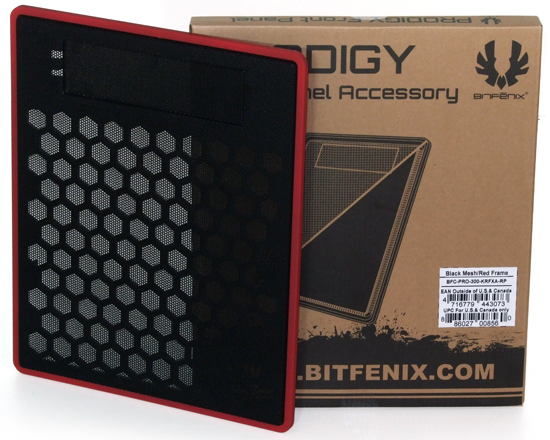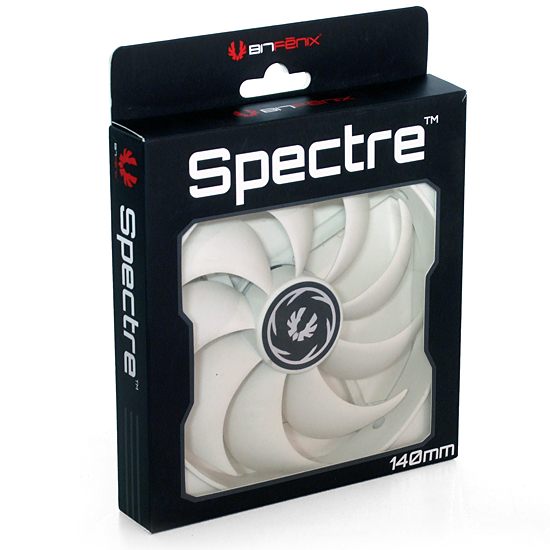System Builder Marathon, Q2 2013: $2500 Performance PC
Case And Its Accessories
Case: BitFenix Prodigy
Most small cases suffer from limited cooling, and this build was going to pack one of the hottest video cards on the market. Nvidia's GeForce GTX 690 vents from both ends and draws air from the side, so the perfect case would have vents up front and back, along with air inlets next to the card.
Read Customer Reviews of BitFenix's Prodigy
Cubitek’s all-aluminum Mini-Tank
is no longer an option, but BitFenix carries the same layout into a cheaper plastic-and-steel model with similar cooling capabilities and a few upgrade tricks. The side panel air inlet is plainly visible from the left side, making this a good start towards my cooling goals, but what about the front vent?
Face Panel: C-PRO-300-KRFXA-RP
I normally don’t go for brightly-colored cases, but white was the only other available option on the day I ordered my chassis. And white-framed mesh face panels were out-of-stock.
Read Customer Reviews of BitFenix's Custom Front Panel
Get Tom's Hardware's best news and in-depth reviews, straight to your inbox.
Typically this is an accessory. Today, however, BitFenix’s mesh-covered front panel upgrade becomes a necessity when a graphics card blows hot air out of both ends. Then again, that panel is only used for exhaust if I reverse the case's airflow.
Front Fan: BFF-SCF-14025WW-RP
The Prodigy’s stock 120 mm intake fan is mounted to the lower face panel, blowing through its hard drive cage into the power supply. Its second 120 mm front mount crosses over the optical drive tray, requiring tray removal. Between those two, a third set of mounting holes supports 140 mm fans exclusively. Not knowing this, I didn’t order one.
Read Customer Reviews of BitFenix's Spectre Pro 140 mm Case Fan
Fortunately, BitFenix saw fit to send me a couple fan samples for a previous review. Those samples were still current models at Newegg, and those samples were still sitting in a cabinet of unused parts. Turning it around as front-panel exhaust completes the airflow-reversal required to keep graphics-card heat away from the CPU. Surprisingly adequate for that intended purpose, I added it to the build sheet.
Current page: Case And Its Accessories
Prev Page Motherboard, Graphics, And CPU Next Page CPU Cooling, Optical Drive, And Power-
sherlockwing Interesting $2500 MITX build, granted most people(including me) would have built a $2500 rig around 780 SLI in a ATX case.Reply -
burnley14 This just might be my favorite SBM ever, and this particular build my favorite machine of all time. Even if the relative value is slightly lower, many people including myself are willing to pay a small premium for a smaller footprint. Well done!Reply -
slomo4sho Seems I was pretty close in my initial guess:Reply
11002870 said:PCPartPicker part list / Price breakdown by merchant / Benchmarks
CPU: Intel Core i7-3770K 3.5GHz Quad-Core Processor ($319.99 @ Newegg)
CPU Cooler: Corsair H110 94.0 CFM Liquid CPU Cooler ($119.99 @ Newegg)
Motherboard: Asus P8Z77-I DELUXE/WD Mini ITX LGA1155 Motherboard ($207.55 @ Newegg)
Memory: Corsair Dominator Platinum 8GB (2 x 4GB) DDR3-2133 Memory ($149.99 @ Newegg)
Storage: Samsung 840 Series 500GB 2.5" Solid State Disk ($353.98 @ Newegg)
Storage: Western Digital Caviar Black 2TB 3.5" 7200RPM Internal Hard Drive ($159.99 @ Newegg)
Video Card: Asus GeForce GTX 690 4GB Video Card ($999.99 @ Newegg)
Case: BitFenix Prodigy (Black) Mini ITX Tower Case ($95.98 @ Newegg)
Power Supply: SeaSonic 660W 80 PLUS Platinum Certified ATX12V / EPS12V Power Supply ($148.54 @ Newegg)
Optical Drive: LG WH14NS40 Blu-Ray/DVD/CD Writer ($59.99 @ Newegg)
Total: $2597.99 -
agnickolov I wish the build had a 512GB SSD, but I understand the builder's value sentiment. The fast HDD is pure waste, however. A 2TB HDD can be found for under $100.Reply -
sarinaide Still struggling to get my mind on a high performance ITX system, to me its more a case of how much high end you can chuck into a psuedo M-ITX chassis which for all intents and purposes are not small form factor by any stretch of the imagination. Having owned a Prodigy they can hardly be said to be SFF when their total surface area is as much as a ATX chassis, it is like calling a HAF XB M-ITX.Reply
The main point of the article is that diminishing returns are high at that price point, only a overclocked system (again not a fan of in the confineds of a ITX system) give it value. -
csf60 I would take a 770 and water-cool that rig any day, but I suppose that's personal preference.Reply -
sarinaide It is safe to say that the purpose of the machine is gaming, for that is there any particular reason to go with the i7 other than to say you maxed the platforms highest capable chip but in terms of true benefits there is little over an i5 yet over a $100 been dropped on it. The next question is why not a GTX Titan, most of a 690 's performance but on less power and heat which is quite punishing in a Prodigy's confinds.Reply -
Crashman Reply
At the initialization's initiation, SFF meant "Shuttle Form Factor". The term has since been abused for everything from Micro ATX gaming cubes to book-sized PCs. Book-sized system builders would argue that Shuttle's fairly big traditional boxes aren't true SFF because they're too big, even though the term originally referred to these! If you remove the handles, this case is roughly the size of Shuttle's old 2-slot boxes (it's around 2 inches taller and 2 inches shorter in length)11028708 said:Still struggling to get my mind on a high performance ITX system, to me its more a case of how much high end you can chuck into a psuedo M-ITX chassis which for all intents and purposes are not small form factor by any stretch of the imagination. Having owned a Prodigy they can hardly be said to be SFF when their total surface area is as much as a ATX chassis, it is like calling a HAF XB M-ITX.
The main point of the article is that diminishing returns are high at that price point, only a overclocked system (again not a fan of in the confineds of a ITX system) give it value.
Gaming only? Then when the Core i7?11028926 said:It is safe to say that the purpose of the machine is gaming
Read pages 16 and 1711028926 said:is there any particular reason to go with the i7
Did you see the overclocking section? Three mediocre i5's in a row and i7 leads to O/C victory, in addition to the gains on pages 16 and 17.11028926 said:other than to say you maxed the platforms highest capable chip but in terms of true benefits there is little over an i5
Did you see a heat issue? I did not. Why would someone want to spend more money for less gaming performance? Or are you now saying that this is not a gaming PC?11028926 said:The next question is why not a GTX Titan, most of a 690 's performance but on less power and heat which is quite punishing in a Prodigy's confinds.







